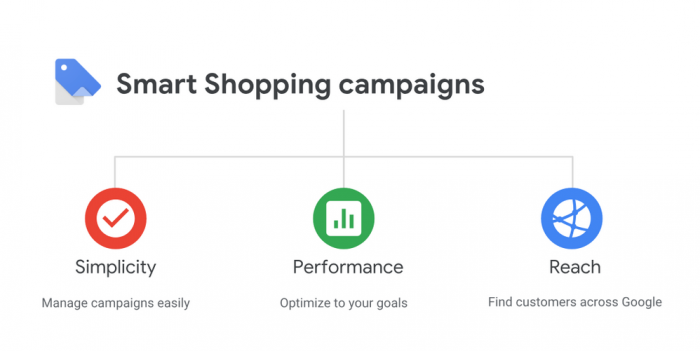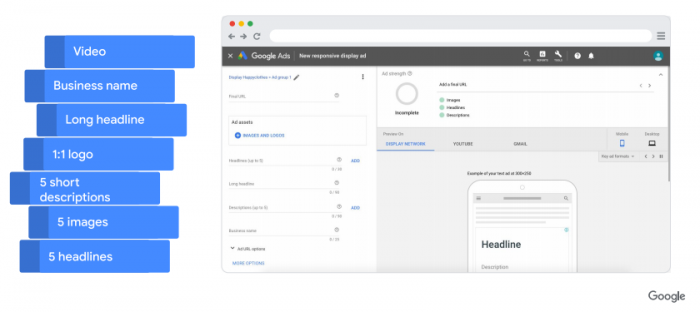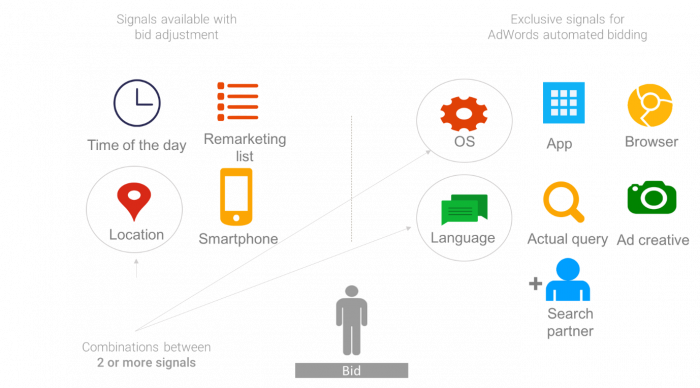Automation and Smart campaigns have been part of PPC for years, but 2019 has seen a strong increase in the adoption of machine learning and a move away from traditional campaigns which use manual bidding.
Each Smart campaign variation comes with benefits, drawbacks and limitations, but they’re all being pushed by Google to pay-per-click marketers.
At Coast Digital our PPC experts have experimented with a variety of Smart campaigns and wanted to let you know what they are, what they can do and some of the pros and cons they face.
-
- Smart Shopping
Smart shopping campaigns use your product feed and assets, and utilise machine learning to effectively show ads across a wider range of networks. Google will concurrently test a variety of ad combinations to learn which are most relevant and which perform best.Smart shopping ads can be displayed on the Google Search Network, Display Network, YouTube and Gmail.
- Smart Shopping

-
- Smart Display
Smart Display campaigns use three optimisation techniques to reach users in all stages of the conversion cycle. These include:- Automated bidding
- Automated targeting
- Automated ad creation
Instead of setting up targeting as you would in a normal display campaign, Google uses signals from existing paid activity to reach new users. You would then upload a selection of headlines, descriptions, logos and images which Google uses to create responsive ads.
Responsive display ads can fit into almost all ad spaces across the Google Display Network, and we’ve often found more success with these than more traditional banner formats such as HTML5 and GIFs.
- Smart Display

- Dynamic Search Ads (DSA)
Dynamic Search Ads, also known as DSA campaigns, use your websites content to find and target new customers. Headlines and landing pages are determined based on the users search query, ensuring your ads are highly relevant to every search.When someone searches for a keyword which closely matches or relates to your websites content, Google Ads will use these phrases to create a clear, relevant and enticing headline for the ad. You can choose to target the entire site, or filter it to target just a few select pages which are highly relevant to your offering.To learn more about dynamic search ads and how they can work for you, take a look at the official Google Ads guide here.
- Automated Bid Strategies
Automated bid strategies, sometimes referred to as Smart bidding, use advanced machine learning algorithms to modify bids to each individual auction. These take numerous factors into account, including time of day, device, location, remarketing lists and more, to ensure bids are tailored to each search query.Automated bid strategies currently include:- Target CPA – ideal for advertisers with a strict cost per acquisition target
- Target ROAS – helps advertisers meet specific return on ad spend targets
- Maximise clicks – increase site visits within your budget
- Maximise conversion value – increase conversion value within your budget
- Target impression share – increase visibility and remain in top positions above competitors

These all come with similar pros and cons, however it’s worth considering each Smart product in detail before implementing them in your account.
Pros
- Increased reach: Smart campaigns are great for expanding your targeting into new areas which you may not have previously considered. By utilising audience insights from user behaviour, Google is able to target people throughout their journey to a conversion.
- Less time spent on monitoring bids: Using automation removes the need to regularly update bids, as well as bid modifiers for devices, ad schedules and demographics. This therefore spares you time and effort, which can be refocused on things like strategy, ad copy review and keyword expansion.
- Keyword mining: DSA’s are great for finding new keywords which you may not have targeted in the account before, based on your websites content. This can also help you to stay ahead of any trends, as new keywords can be mined before competitors begin to aggressively bid on them.
- Geared towards smaller businesses: Automated campaigns are ideal for small and medium-sized enterprises (SMEs) who are looking to get into advertising as they require limited maintenance and very little knowledge to set up.
- Goal focused: Once you’ve set the goals you want to work towards, the Smart campaigns will optimise themselves towards them, in order to deliver great results consistently.
- Improved efficiency: Smart campaigns and campaigns using Smart bidding tend to have higher click-through rates and conversion rates due to their highly relevant nature. By tailoring each ad or bid to the user, you can quickly increase conversions within your budget.
Cons
- Lack of control: With automation comes a loss of control, be it over bids, targeting, negative keywords or ad creative. This can be difficult for those who need certain elements to show in ads every time, or if you don’t want to pay over a certain amount per click. Difficulties also arise when you notice a particular placement, search query or device that is under performing, but are unable to block it from the campaign.
- Higher bids: Although Smart campaigns and bid strategies do tend to increase efficiency, they can also have a negative impact on bids. Bid strategies such as “maximise clicks” can dramatically raise bids but produce just incremental changes in performance.
- No visibility into the reasoning behind changes or performance: On some days, you could see a 50% increase in CPC, however Google provides you no update on why this may have happened. This can be hard to explain to your wider team and can cause frustrations when performance isn’t at the level you’d like. However, the recently introduced BETA “Explanations” may help to answer these questions in some cases.
- Budget pacing: As Smart campaigns use machine learning to determine how budget should be allocated based on your goals, it can be difficult to regulate where your budget will be spent. This can cause problems for advertisers when seasonality is important, or when goals regularly change. You may therefore find that your Smart campaigns budget is not spent as efficiently as possible.
- Targeting may include remarketing: Smart campaigns do incorporate a level of remarketing, however it’s unclear as to how much this makes up of the overall targeting. When we test excluding audience lists, we often see a sharp dip in performance, suggesting this makes up for a larger portion of targeting than you may want.
In summary, automation is becoming increasingly more effective and valuable to advertisers, but it does come with its limitations. A human aspect is almost always required for the management of campaigns to monitor elements that a Smart campaign cannot yet understand, such as search queries, average customer value and seasonality.
It’s best practice to incorporate automation into your account where possible, but we always suggest monitoring performance closely in the initial weeks following the launch, keeping an eye out for teething problems. There’s also a range of scripts available to help you monitor results, including this one from Search Engine Land.
If you’re keen to start using automation but not sure where to start, why not get in touch and talk to one of our experts today?
